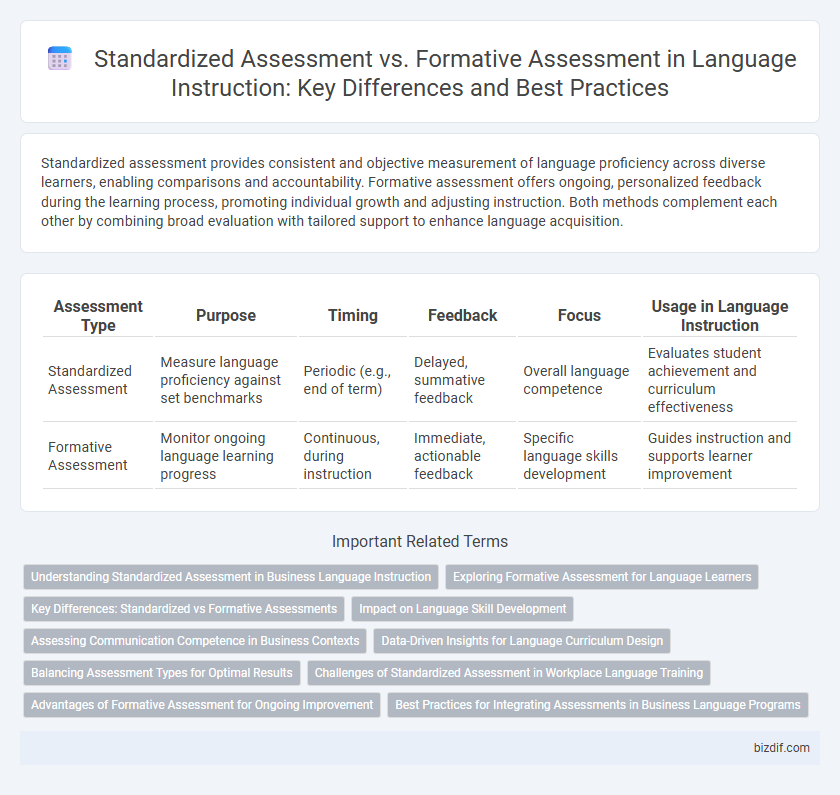Standardized assessment provides consistent and objective measurement of language proficiency across diverse learners, enabling comparisons and accountability. Formative assessment offers ongoing, personalized feedback during the learning process, promoting individual growth and adjusting instruction. Both methods complement each other by combining broad evaluation with tailored support to enhance language acquisition.
Table of Comparison
| Assessment Type | Purpose | Timing | Feedback | Focus | Usage in Language Instruction |
|---|---|---|---|---|---|
| Standardized Assessment | Measure language proficiency against set benchmarks | Periodic (e.g., end of term) | Delayed, summative feedback | Overall language competence | Evaluates student achievement and curriculum effectiveness |
| Formative Assessment | Monitor ongoing language learning progress | Continuous, during instruction | Immediate, actionable feedback | Specific language skills development | Guides instruction and supports learner improvement |
Understanding Standardized Assessment in Business Language Instruction
Standardized assessment in business language instruction evaluates learners' proficiency through uniform tests, ensuring consistent measurement of language skills across diverse groups. These assessments provide quantifiable data for benchmarking performance against industry standards, facilitating objective comparisons and certification processes. Unlike formative assessments, standardized tests focus on summative evaluation, emphasizing measurable outcomes in areas such as business vocabulary, communication accuracy, and comprehension.
Exploring Formative Assessment for Language Learners
Formative assessment in language instruction provides ongoing feedback that adapts to individual learners' needs, unlike standardized assessments that offer a fixed evaluation. Techniques such as observational notes, interactive activities, and reflective journals support language acquisition by highlighting progress and areas for improvement in real time. This approach fosters personalized learning pathways, enhancing language proficiency through continuous, contextualized feedback.
Key Differences: Standardized vs Formative Assessments
Standardized assessments measure language proficiency through uniform tests scored objectively, providing comparative data across diverse populations. Formative assessments involve ongoing, interactive evaluations that guide instructional adjustments and promote learner development in real-time. The key difference lies in standardized tests emphasizing summative evaluation and accountability, while formative assessments prioritize personalized feedback and continuous improvement.
Impact on Language Skill Development
Standardized assessments provide quantifiable data on language proficiency, enabling benchmarking across diverse populations but may overlook individual learning nuances. Formative assessments offer ongoing feedback, fostering personalized instruction that directly enhances speaking, listening, reading, and writing skills. Integrating both assessment types supports comprehensive language skill development by balancing objective measurement with adaptive teaching strategies.
Assessing Communication Competence in Business Contexts
Standardized assessments measure communication competence through uniform tasks and scoring criteria, providing objective data on language proficiency in business contexts. Formative assessments enable ongoing evaluation of learners' practical communication skills, allowing targeted feedback and adaptation to specific business scenarios. Combining both approaches enhances accuracy in assessing communicative effectiveness and intercultural competence critical for business success.
Data-Driven Insights for Language Curriculum Design
Standardized assessment provides quantifiable data on learner proficiency across large populations, offering benchmarks for language curriculum effectiveness. Formative assessment delivers real-time, nuanced insights into individual learner progress, enabling targeted instructional adjustments. Integrating both methods yields comprehensive data-driven insights that enhance language curriculum design by aligning teaching strategies with learner needs and performance trends.
Balancing Assessment Types for Optimal Results
Balancing standardized assessments and formative assessments is essential for comprehensive language instruction, as standardized tests provide objective data on language proficiency while formative assessments offer ongoing insights into learner progress and instructional effectiveness. Integrating both types enables educators to target specific language skills, adapt teaching strategies, and support diverse learner needs. Optimal results emerge from leveraging standardized benchmarks alongside continuous formative feedback to enhance language acquisition and retention.
Challenges of Standardized Assessment in Workplace Language Training
Standardized assessments in workplace language training often fail to capture the diverse communication needs of employees, leading to inaccuracies in skill evaluation and limited practical applicability. These assessments typically emphasize uniformity and scoring benchmarks, which may overlook context-specific language competencies crucial for job performance. Organizations face challenges in aligning standardized test results with real-world language use, hindering tailored training interventions and employee development.
Advantages of Formative Assessment for Ongoing Improvement
Formative assessment provides continuous feedback that allows language instructors to identify learners' strengths and weaknesses in real time, facilitating tailored instruction adjustments. This approach supports active learner engagement by encouraging self-reflection and goal setting, which enhances language acquisition. Frequent, low-stakes assessments reduce anxiety and promote a growth mindset, directly contributing to more effective language proficiency development.
Best Practices for Integrating Assessments in Business Language Programs
Effective business language programs prioritize integrating standardized and formative assessments to measure learner progress accurately and adapt instruction. Standardized assessments provide objective benchmarks aligned with industry proficiency levels such as the Common European Framework of Reference for Languages (CEFR), while formative assessments offer ongoing feedback to tailor curriculum and enhance communication skills. Best practices include balancing these assessment types, using data-driven insights to personalize training, and aligning evaluation methods with specific business language competencies and real-world workplace scenarios.
Standardized assessment vs formative assessment Infographic

 bizdif.com
bizdif.com